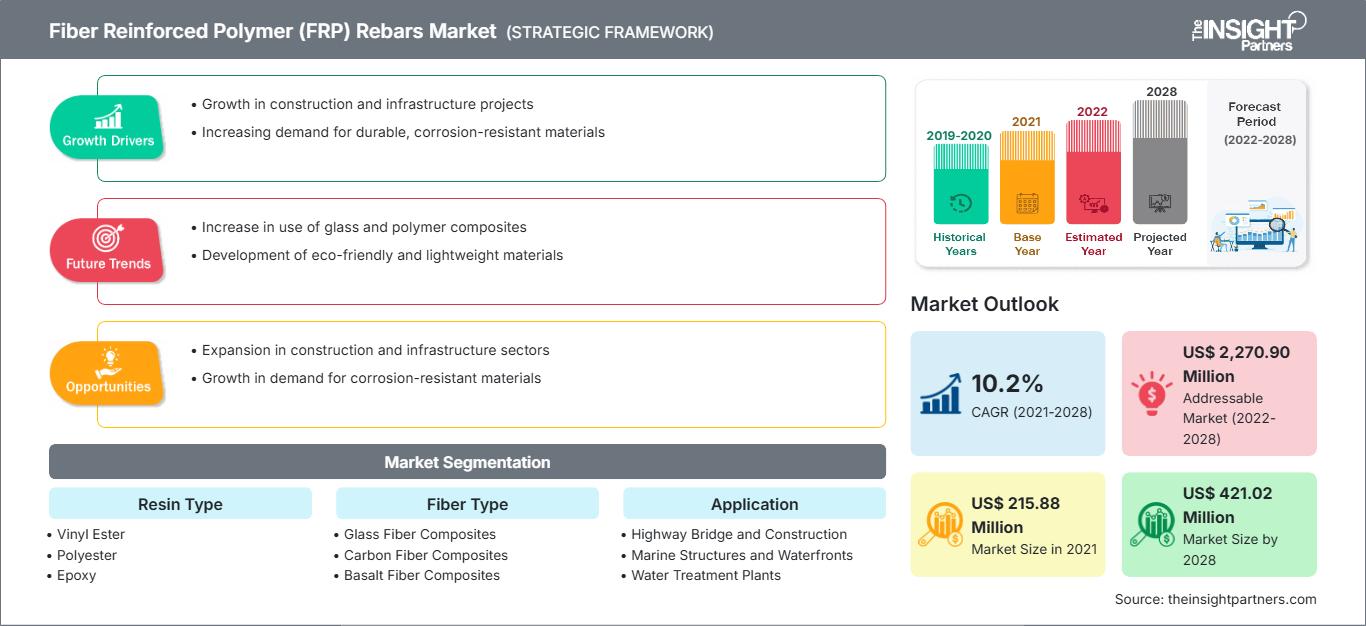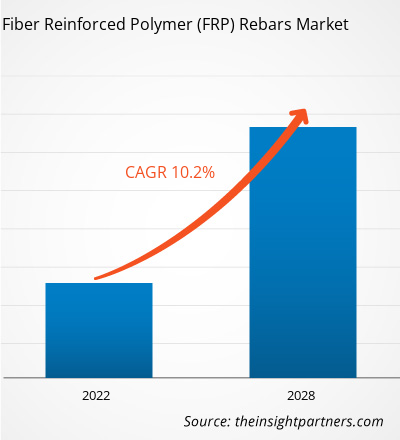Si prevede che il mercato delle barre d'armatura in polimero rinforzato con fibre (FRP) crescerà da 215,88 milioni di dollari nel 2021 a 421,02 milioni di dollari entro il 2028; si stima una crescita a un CAGR del 10,2% dal 2022 al 2028.
Poiché il calcestruzzo è resistente alla compressione e debole alla trazione, viene tipicamente rinforzato per creare un materiale da costruzione resistente sia alla trazione che alla compressione. Questo rinforzo è tradizionalmente costituito da acciaio per il suo basso costo, l'elevata resistenza e l'elevata elasticità. Tuttavia, la corrosione dell'acciaio potrebbe costare a governi e proprietari di immobili miliardi di dollari in costi di manutenzione per sostituire o riparare infrastrutture obsolete. Esistono poche alternative ai materiali di rinforzo del calcestruzzo che possono essere utilizzate per prevenire la corrosione. Ad esempio, alcuni produttori offrono barre d'armatura in acciaio inossidabile; tuttavia, le barre d'armatura in polimero rinforzato con fibre possono fungere da alternativa non corrosiva alle barre d'armatura in acciaio convenzionali per il rinforzo del calcestruzzo. Queste barre d'armatura in FRP sono realizzate combinando una matrice polimerica con fibre di vetro, carbonio o basalto. Questi materiali non arrugginiscono, sono molto più leggeri dell'acciaio, non trasmettono calore e sono quasi quattro volte più resistenti alla trazione. La capacità anticorrosiva rende il polimero rinforzato con fibre la migliore alternativa per varie applicazioni edilizie come muri di contenimento, moli, banchine, cassoni, pontili, paratie, palificazioni, canali, piattaforme offshore, piscine e acquari.
Inoltre, nelle applicazioni elettromagneticamente sensibili, le proprietà non conduttive del vetro e del polimero delle barre d'armatura in FRP non trasmettono corrente, non attraggono fulmini e non interferiscono con il funzionamento di dispositivi elettrici nelle vicinanze. Ciò rende il polimero rinforzato con fibre un'alternativa più sicura all'acciaio negli impianti di fusione di alluminio e rame, nelle torri aeroportuali, nelle centrali nucleari, nelle strutture militari specializzate, nelle torri di trasmissione elettrica e telefonica, nei tombini contenenti apparecchiature elettriche o telefoniche e negli ospedali dotati di apparecchiature per la risonanza magnetica (RM).
Personalizza questo rapporto in base alle tue esigenze
Potrai personalizzare gratuitamente qualsiasi rapporto, comprese parti di questo rapporto, o analisi a livello di paese, pacchetto dati Excel, oltre a usufruire di grandi offerte e sconti per start-up e università
Mercato delle barre d'armatura in polimero rinforzato con fibre (FRP): Approfondimenti strategici

-
Ottieni le principali tendenze chiave del mercato di questo rapporto.Questo campione GRATUITO includerà l'analisi dei dati, che vanno dalle tendenze di mercato alle stime e alle previsioni.
Approfondimenti di mercato
La crescita delle attività di costruzione stimola la crescita del mercato delle barre d'armatura in polimeri rinforzati con fibre (FRP)
Il settore delle costruzioni è uno dei principali fattori che contribuiscono allo sviluppo economico globale. Sta prosperando rapidamente grazie al crescente sostegno governativo allo sviluppo infrastrutturale in tutto il mondo. Ad esempio, l'India ha pianificato di investire 1,4 trilioni di dollari in infrastrutture attraverso il National Infrastructure Pipeline dal 2019 al 2023. In questo piano, il governo ha incluso infrastrutture come centrali elettriche, ponti, dighe, strade e sviluppo di infrastrutture urbane. Grazie alle loro vantaggiose proprietà, come l'elevata resistenza, la tolleranza al gelo e ai sali antighiaccio e i brevi tempi di installazione con minima interferenza con il traffico, i polimeri rinforzati con fibre si sono evoluti fino a diventare preziosi materiali da costruzione sostitutivi per le strutture dei ponti. Si prevede che tali iniziative dei governi di diversi paesi stimoleranno la crescita del mercato delle barre d'armatura in polimero rinforzato con fibre (FRP).
Approfondimenti sui tipi di resina
In base al tipo di resina, il mercato globale delle barre d'armatura in polimero rinforzato con fibre (FRP) è segmentato in vinilestere, poliestere, epossidico e altri. Nel 2021, il segmento vinilestere deteneva la quota di mercato maggiore. Le resine vinilestere presentano un'elevata resistenza; un'elevata resistenza alla corrosione, ai carburanti, alle sostanze chimiche o ai vapori; e offrono tenacità meccanica. Hanno un'elevata durabilità, resistenza al calore e un'elevata resistenza all'allungamento a trazione. Questa resina può essere impregnata con fibre di vetro corte o fibre di carbonio per produrre barre d'armatura in FRP. La maggior parte dei produttori di barre d'armatura in polimero rinforzato con fibre utilizza resina vinilestere. L'economicità della resina vinilestere ha favorito la crescita del segmento.
Owens Corning; KODIAC Fiberglass Rebar; MARSHALL COMPOSITE TECHNOLOGIES, LLC; TUF-BAR; Armastek USA; Pultron Composites; FiRep Inc.; PULTRALL, Inc.; Schock Bauteile GmbH; e Dextra Group sono tra i principali attori operanti nel mercato globale delle barre d'armatura in polimero rinforzato con fibre (FRP). I principali attori adottano strategie come fusioni, acquisizioni e lanci di prodotti per espandere la propria presenza geografica e la propria clientela. Ad esempio, Pultron Composites ha stretto una partnership con Saudi Aramco, la principale compagnia petrolifera saudita, per ampliare i suoi impianti di produzione di barre d'armatura in polimero rinforzato con fibre di vetro (GFRP) nel Paese.
Approfondimenti regionali sul mercato delle barre d'armatura in polimero rinforzato con fibre (FRP)
Le tendenze e i fattori regionali che influenzano il mercato delle barre d'armatura in polimero rinforzato con fibre (FRP) durante il periodo di previsione sono stati ampiamente spiegati dagli analisti di The Insight Partners. Questa sezione illustra anche i segmenti e la distribuzione geografica del mercato delle barre d'armatura in polimero rinforzato con fibre (FRP) in Nord America, Europa, Asia-Pacifico, Medio Oriente e Africa, America Meridionale e Centrale.
Ambito del rapporto di mercato sulle barre d'armatura in polimero rinforzato con fibre (FRP)
| Attributo del rapporto | Dettagli |
|---|---|
| Dimensioni del mercato in 2021 | US$ 215.88 Million |
| Dimensioni del mercato per 2028 | US$ 421.02 Million |
| CAGR globale (2021 - 2028) | 10.2% |
| Dati storici | 2019-2020 |
| Periodo di previsione | 2022-2028 |
| Segmenti coperti |
By Tipo di resina
|
| Regioni e paesi coperti |
Nord America
|
| Leader di mercato e profili aziendali chiave |
|
Densità degli attori del mercato delle barre d'armatura in polimero rinforzato con fibre (FRP): comprendere il suo impatto sulle dinamiche aziendali
Il mercato delle barre d'armatura in polimero rinforzato con fibre (FRP) è in rapida crescita, trainato dalla crescente domanda degli utenti finali dovuta a fattori quali l'evoluzione delle preferenze dei consumatori, i progressi tecnologici e una maggiore consapevolezza dei vantaggi del prodotto. Con l'aumento della domanda, le aziende stanno ampliando la propria offerta, innovando per soddisfare le esigenze dei consumatori e sfruttando le tendenze emergenti, alimentando ulteriormente la crescita del mercato.

- Ottieni il Mercato delle barre d'armatura in polimero rinforzato con fibre (FRP) Panoramica dei principali attori chiave
In evidenza nel rapporto
- Tendenze progressive nel settore delle barre d'armatura in polimero rinforzato con fibre (FRP) per aiutare gli operatori a sviluppare strategie efficaci a lungo termine
- Strategie di crescita aziendale adottate dalle aziende per garantire la crescita nei mercati sviluppati e in via di sviluppo
- Analisi quantitativa del mercato globale delle barre d'armatura in polimero rinforzato con fibre (FRP) dal 2022 al 2028
- Stima della domanda di barre d'armatura in polimero rinforzato con fibre (FRP)
- Analisi di Porter per illustrare l'efficacia di acquirenti e fornitori che operano nel settore nel prevedere la crescita del mercato
- Sviluppi recenti per comprendere lo scenario competitivo del mercato e la domanda di barre d'armatura in polimero rinforzato con fibre (FRP)
- Tendenze e prospettive di mercato e fattori che guidano e frenano la crescita del mercato globale delle barre d'armatura in polimero rinforzato con fibre (FRP)
- Comprendere le strategie che sostengono l'interesse commerciale per quanto riguarda il mercato globale Crescita del mercato delle barre d'armatura in polimero rinforzato con fibre (FRP), a supporto del processo decisionale
- Dimensioni del mercato globale delle barre d'armatura in polimero rinforzato con fibre (FRP) in diversi nodi di mercato
- Panoramica dettagliata e segmentazione del mercato globale delle barre d'armatura in polimero rinforzato con fibre (FRP) e delle sue dinamiche di settore
- Dimensioni del mercato globale delle barre d'armatura in polimero rinforzato con fibre (FRP) in diverse regioni con promettenti opportunità di crescita
L'"Analisi del mercato delle barre d'armatura in polimero rinforzato con fibre (FRP) fino al 2028" è uno studio specializzato e approfondito del settore chimico e dei materiali, incentrato sull'analisi delle tendenze del mercato delle barre d'armatura in polimero rinforzato con fibre (FRP). Il rapporto mira a fornire una panoramica del mercato con una segmentazione dettagliata. Il mercato delle barre d'armatura in polimero rinforzato con fibre (FRP) è segmentato in base al tipo di resina, al tipo di fibra, all'applicazione e all'area geografica. In base al tipo di resina, il mercato è segmentato in vinilestere, poliestere, epossidico e altri. In base al tipo di fibra, il mercato è segmentato in compositi in fibra di vetro, compositi in fibra di carbonio e compositi in fibra di basalto. In base all'applicazione, il mercato è segmentato in ponti e costruzioni autostradali, strutture marine e litorali, impianti di trattamento delle acque e altri. In base all'area geografica, il mercato è segmentato in cinque regioni principali: Nord America, Europa, Asia-Pacifico, Medio Oriente e Africa e Sud e Centro America. Nel 2021, il Nord America ha dominato il mercato delle barre d'armatura in polimero rinforzato con fibre (FRP). Tuttavia, si prevede che l'Asia-Pacifico registrerà il CAGR più elevato del mercato durante il periodo di previsione.
- Analisi storica (2 anni), anno base, previsione (7 anni) con CAGR
- Analisi PEST e SWOT
- Valore/volume delle dimensioni del mercato - Globale, Regionale, Nazionale
- Industria e panorama competitivo
- Set di dati Excel
Report recenti
Testimonianze
Motivo dell'acquisto
- Processo decisionale informato
- Comprensione delle dinamiche di mercato
- Analisi competitiva
- Analisi dei clienti
- Previsioni di mercato
- Mitigazione del rischio
- Pianificazione strategica
- Giustificazione degli investimenti
- Identificazione dei mercati emergenti
- Miglioramento delle strategie di marketing
- Aumento dell'efficienza operativa
- Allineamento alle tendenze normative






















 Ottieni un campione gratuito per - Mercato delle barre d'armatura in polimero rinforzato con fibre (FRP)
Ottieni un campione gratuito per - Mercato delle barre d'armatura in polimero rinforzato con fibre (FRP)